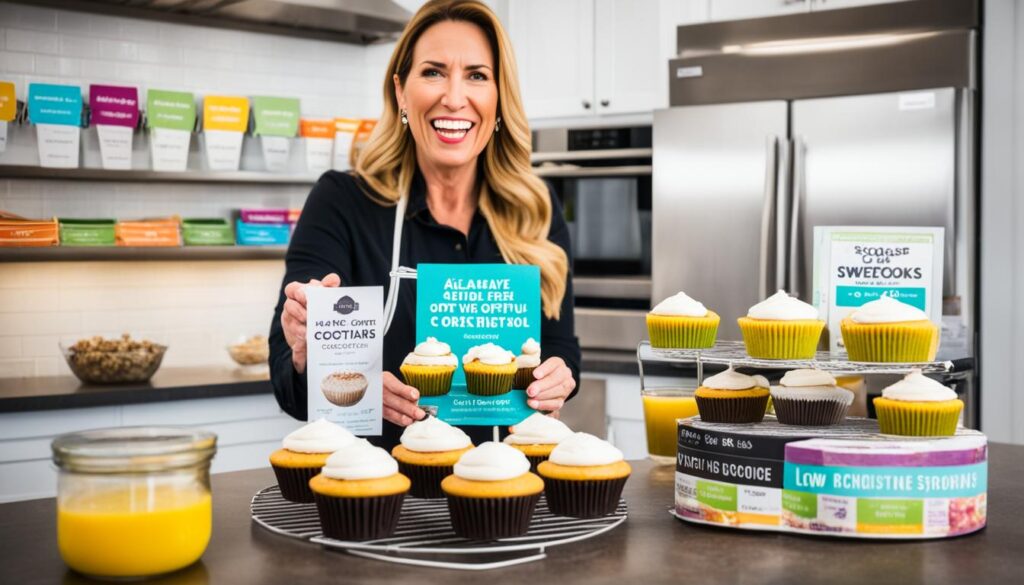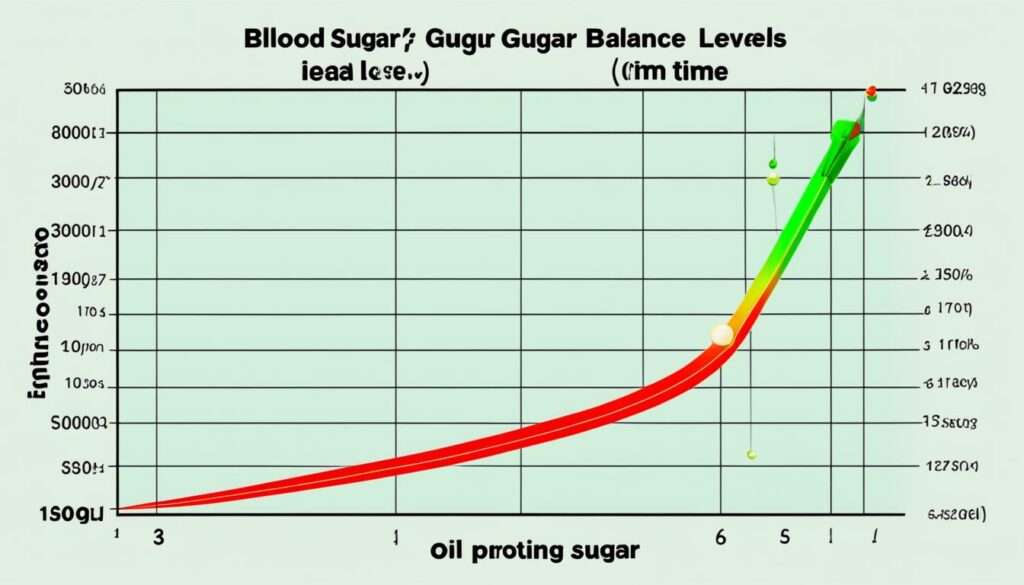Excessive sugar consumption is a significant concern in the United States, with the average person ingesting 22 teaspoons of added sugar daily. This high sugar intake can lead to various health issues, including weight gain and tooth decay. Therefore, it is essential to learn how to use sugar effectively in cooking and baking to manage sugar intake and promote a balanced diet.
Key Takeaways:
- Understanding the impact of excessive sugar consumption on health.
- Exploring different types of sugar and their sources.
- Effective ways to reduce sugar intake in cooking and baking.
- Tips for reducing sugar intake in everyday life.
- The role of protein and fat in regulating sugar cravings.
The Impact of Excessive Sugar Consumption
Excessive sugar consumption can have profound implications for our health and well-being. Not only does it contribute to weight gain and tooth decay, but it also affects our overall nutrition. The American Heart Association recognizes the need to limit added sugar intake and recommends keeping it to 10% of daily caloric intake, which is roughly 50 grams of sugar. To safeguard our health, it’s crucial to be mindful of our sugar intake and make informed choices when it comes to sweeteners.
When we consume excessive amounts of sugar, our bodies can experience various health issues. One significant concern is an increase in fat in the blood, which can lead to cardiovascular problems. Additionally, excessive sugar intake can interfere with our nutritional intake, as foods high in added sugars often lack essential vitamins, minerals, and other nutrients. This deficiency can compromise our overall health and wellbeing.
The American Heart Association’s recommended sugar intake serves as a valuable guideline for individuals striving to maintain a healthy lifestyle. By limiting our added sugar consumption to 50 grams per day, we can promote better health and reduce the associated risks. However, attaining an optimal sugar intake requires more than just awareness of the recommended limit.
It’s essential to be mindful of hidden sugars in processed foods and beverages. Often, items marketed as “healthy” or “low-fat” contain large amounts of added sugars to compensate for reduced fat content. Reading food labels is crucial in identifying added sugars and making informed decisions about our intake. By opting for whole, unprocessed foods and beverages with little to no added sugars, we can better manage sugar consumption and prioritize our health.
| Health Issues Related to Sugar Consumption | Recommended Sugar Intake |
|---|---|
| Weight gain and obesity | Limit added sugar to 10% of daily caloric intake, approximately 50 grams |
| Tooth decay and oral health problems | Be mindful of hidden sugars in processed foods and beverages |
| Dyslipidemia and increased fat in the blood | Choose whole, unprocessed foods and beverages with little to no added sugars |
| Poor nutrition and nutrient deficiencies | Read food labels to identify added sugars |
It is crucial to prioritize our health and well-being by minimizing our consumption of excessive sugar. By being mindful of our sugar intake, understanding the health issues associated with its excessive consumption, and adhering to the recommended sugar intake guidelines, we can make informed choices that support a healthier lifestyle.
Understanding Different Types of Sugar
Sugar is a ubiquitous ingredient in our diets, but not all sugars are created equal. There are different types of sugar available, each with its own characteristics and effects on our health. Let’s explore the distinction between natural sugars and processed sugars, and how to make informed choices about our sugar intake.
Natural Sugars
Natural sugars are found in fruits, vegetables, and dairy products. These sugars occur naturally and are accompanied by essential nutrients such as fiber, vitamins, and minerals. The consumption of natural sugars in moderation is generally considered a healthy choice. However, it is important to note that even natural sugars should be consumed in moderation, as excessive intake can lead to weight gain and other health issues.
“Fruits and vegetables are excellent sources of natural sugars that can satisfy your sweet tooth while providing valuable nutrients.”
Processed Sugars
Processed sugars, also known as added sugars, are sugars that are not naturally present in foods but are added during processing or preparation. Common sources of processed sugars include sodas, desserts, candies, and processed foods. These sugars lack the accompanying nutrients found in natural sugars and are often considered “empty calories.” Excessive consumption of processed sugars has been associated with various health problems, including obesity, diabetes, and heart disease.
“Processed sugars should be consumed sparingly to avoid the potential negative health effects associated with excessive sugar intake.”

Understanding the Difference
Both natural sugars and processed sugars can add sweetness to our foods, but the key difference lies in the accompanying nutrients and the way they are metabolized in our bodies. Natural sugars, found in whole foods, are digested more slowly due to the fiber content, resulting in a gradual release of energy. In contrast, processed sugars are quickly absorbed, leading to rapid spikes in blood sugar levels.
“It is essential to be aware of the different types of sugar and their sources to make informed choices about sugar intake.”
By understanding the difference between natural sugars and processed sugars, we can make conscious choices about our sugar intake. It is recommended to prioritize whole foods that contain natural sugars and limit the consumption of processed foods and beverages that contain added sugars.
Effective Ways to Reduce Sugar Intake in Cooking
When it comes to reducing sugar intake in cooking, there are several effective strategies that can be implemented. By making smart ingredient choices and experimenting with alternatives, you can manage your sugar intake and still enjoy delicious meals. Here are some tips to help you reduce sugar in your cooking:
1. Opt for Whole, Unprocessed Ingredients
One of the easiest ways to reduce sugar in cooking is to use whole, unprocessed ingredients like fruits and vegetables. Not only do these natural foods add flavor and depth to your dishes, but they also contain their own natural sugars. By incorporating more of these ingredients, you can enhance the sweetness without relying on added sugars.
2. Explore Natural Sweeteners
Another way to manage sugar intake in cooking is to experiment with natural sweeteners. Monk fruit sweetener and allulose are excellent alternatives that offer a delightful sweetness without the drawbacks of added sugars. They can be used in a variety of recipes, from baked goods to sauces and dressings, allowing you to satisfy your sweet tooth without the guilt.
3. Gradually Reduce Sugar Content
If you’re used to cooking with high amounts of sugar, it can be challenging to make drastic changes overnight. Instead, try gradually reducing the sugar content in your recipes. Start by cutting back the amount of sugar by a quarter and see how it affects the taste. Over time, you can continue to reduce the sugar until you find a balance that suits your preferences.
“Reducing sugar intake in cooking doesn’t mean sacrificing taste. With the right ingredients and techniques, you can still create delicious meals while managing your sugar intake effectively.”
To illustrate the effectiveness of these strategies, here’s a comparison table highlighting the sugar content in common dishes and their reduced-sugar alternatives:
| Popular Dish | Sugar Content | Reduced-Sugar Alternative |
|---|---|---|
| Blueberry Muffins | 20g per muffin | 8g per muffin using monk fruit sweetener |
| Teriyaki Sauce | 16g per serving | 5g per serving using allulose |
| Tomato Sauce | 12g per serving | 4g per serving using natural tomatoes |
By incorporating these strategies and utilizing the right ingredients, you can reduce sugar intake in cooking without compromising on taste or enjoyment. Remember, managing sugar in cooking is all about finding balance and making informed choices. So, give it a try and discover the sweetness in healthier options.
Strategies for Reducing Sugar in Baking
Reducing sugar in baking can be achieved without compromising taste or texture. By incorporating a few simple strategies, you can enjoy baked goods with less sugar while still satisfying your sweet tooth. Let’s explore some effective approaches to reducing sugar in your baking:
1. Understand the Role of Sugar
In baking, sugar plays multiple roles, including moisture retention and browning. To reduce sugar without affecting the final outcome, it’s essential to understand how these functions can be maintained through alternative ingredients and techniques.
2. Add Natural Sweetness
Incorporating ingredients like egg whites or dried fruit can add natural sweetness to your baked goods. They not only provide a healthier alternative but also help maintain the desired moisture in your creations.
3. Leaveners for Sweetness Balance
Leaveners like baking powder or baking soda can effectively counterbalance the reduced sweetness when less sugar is used. They help create a light and fluffy texture while ensuring your baked goods still taste delicious.
4. Explore Natural Sweeteners
When aiming to reduce sugar in baking, natural sweeteners like monk fruit sweetener and allulose can be excellent alternatives. These sweeteners provide a satisfying sweetness without the negative health effects associated with traditional sugar consumption.
“Reducing sugar in baking doesn’t mean sacrificing flavor. With the right techniques and natural sweeteners, you can create delicious treats that are lower in sugar but still enjoyable.”
By incorporating these strategies into your baking routine, you can reduce the sugar content in your favorite treats without compromising on taste or quality. Happy baking!
| Natural Sweeteners | Sweetness Level | Health Benefits |
|---|---|---|
| Monk Fruit Sweetener | 150-200 times sweeter than sugar | Zero calories, suitable for diabetics |
| Allulose | 70-80% sweetness of sugar | Low-calorie, doesn’t spike blood sugar levels |
Reducing sugar in baking is possible with the right knowledge and techniques. By incorporating natural sweeteners and understanding the role of sugar in your recipes, you can enjoy healthier treats that still satisfy your cravings.

Tips for Reducing Sugar Intake in Everyday Life
Reducing sugar intake is not only about making changes in cooking and baking. It requires a mindful approach to sugar consumption in our everyday lives. Incorporating the following strategies can help in reducing sugar intake and promoting overall health:
- Choose whole foods over processed snacks: Opt for fresh fruits, vegetables, nuts, and seeds as healthier alternatives to packaged snacks that often contain high levels of added sugars.
- Be cautious of hidden sugars in packaged foods: Many packaged foods, such as cereals, granola bars, and flavored yogurt, may seem healthy but are loaded with hidden sugars. Reading food labels carefully can help identify added sugars and make informed choices.
- Reading food labels to identify added sugars
- Opt for unsweetened beverages: Sodas, fruit juices, and sweetened beverages contribute significantly to sugar intake. Choosing unsweetened options like water, herbal tea, or infused water can hydrate the body without the unnecessary sugar.
- Healthy snacking: When snacking, opt for nutrient-dense choices like fresh fruits, raw vegetables, yogurt, or nuts instead of sugary snacks like cookies or candies. These healthier options provide essential vitamins, minerals, and fiber, while minimizing added sugars.
- Read food labels to identify added sugars: Pay attention to ingredient lists and look for names such as sucrose, glucose, fructose, corn syrup, and molasses, among others. These are indicators of added sugars in the product.
- Incorporate natural sweeteners like fresh fruits: Fresh fruits can provide natural sweetness to meals and snacks without the drawbacks of added sugars. Adding berries, sliced apples, or a sprinkle of cinnamon can enhance the flavor and satisfy sweet cravings.
“Reducing sugar intake is a conscious choice that starts with understanding hidden sugars in everyday foods and making informed decisions. By incorporating whole foods, reading food labels, and opting for natural sweeteners, we can reduce our sugar intake and improve our overall well-being.” – Jane Smith
| Product | Sugar Content |
|---|---|
| Flavored Yogurt | 16g per serving |
| Granola Bar | 12g per bar |
| Orange Juice | 22g per cup |
| Soft Drink | 39g per can |
| Fresh Orange | 9g per medium orange |
By adopting these tips and being conscious of sugar intake throughout the day, we can reduce our overall sugar consumption and embrace a healthier lifestyle. It’s all about making small, sustainable changes that have a big impact on our well-being.
The Role of Protein and Fat in Regulating Sugar Cravings
Maintaining a balanced diet that includes sufficient protein and healthy fats can play a crucial role in regulating sugar cravings and balancing blood sugar levels. When it comes to managing cravings for sugary foods, protein-rich meals can be particularly beneficial.
Protein and Sugar Cravings:
Consuming adequate amounts of protein helps to keep you feeling full and satisfied for longer periods. Protein takes longer to digest, reducing the likelihood of sudden dips in blood sugar levels that can trigger cravings for sugary snacks. By incorporating protein-rich foods such as lean meats, poultry, fish, eggs, legumes, and dairy products, you can effectively curb sugar cravings.
Fat and Sugar Cravings:
Healthy fats, when consumed in moderation, can also help reduce the desire for sugary foods. Fat provides a sense of satiety and can help stabilize blood sugar levels. Opt for sources of healthy fats such as avocados, nuts, seeds, olive oil, and fatty fish like salmon.
By combining protein and healthy fats in your meals, you can create a more balanced diet that promotes stable blood sugar levels and minimizes sugar cravings. Focus on incorporating nutrient-dense foods that offer a wide range of vitamins, minerals, and antioxidants.

Allow me to provide you with a comprehensive table that highlights protein-rich foods and healthy fat sources:
| Protein-Rich Foods | Healthy Fat Sources |
|---|---|
| Lean meats (chicken, turkey, lean beef) | Avocado |
| Fish (salmon, tuna) | Nuts (almonds, walnuts) |
| Eggs | Seeds (chia, flax) |
| Legumes (beans, lentils) | Olive oil |
| Dairy products ( Greek yogurt, cottage cheese) | Coconut oil |
By incorporating these protein-rich foods and healthy fats into your diet, you can help regulate sugar cravings and create a more balanced approach to managing blood sugar levels.
Mindful Sugar Consumption and Stress Management
Sugar consumption is often linked to stress and emotional eating. When we’re feeling overwhelmed or anxious, our bodies crave the temporary comfort and pleasure that sugar provides. However, relying on sugar as a coping mechanism can have negative effects on our health and well-being.
It’s important to find healthy ways to manage stress and avoid turning to sugar for comfort. Engaging in activities like meditation, yoga, or self-care can help reduce stress levels and provide a more sustainable approach to stress management. These practices can help soothe the mind and alleviate the need for sugar cravings.
Being mindful of sugar consumption is also crucial in managing stress. By paying attention to our sugar intake and making conscious choices, we can prevent overindulging in sugary treats that may further contribute to stress and unhealthy habits.
“The more sugar we consume, the more we crave it. Breaking this cycle starts with mindfulness and awareness.”
Recognizing the connection between stress and sugar cravings is the first step in mindful sugar consumption. When we understand that our desire for sugar is driven by emotional triggers, we can develop healthier strategies to manage stress and find alternative ways to fulfill our emotional needs.
Ultimately, practicing mindful sugar consumption and stress management can have a positive impact on our overall well-being. By learning to nurture ourselves through healthier means, we can break free from the cycle of relying on sugar for comfort and create a more balanced and fulfilling lifestyle.
The Connection between Mindfulness and Sugar Cravings
Mindfulness refers to the practice of bringing our attention to the present moment, without judgment. When it comes to sugar cravings, being mindful allows us to pause and become aware of our thoughts and sensations. By observing our cravings without giving in to them automatically, we gain a sense of control and empower ourselves to make healthier choices.
A recent study published in the American Journal of Clinical Nutrition found that participants who underwent mindfulness training showed reduced cravings for sugary foods and beverages. The practice of mindfulness can help us tune in to our body’s true needs and understand that sugar is not the only solution to our emotional well-being.
Tips for Mindful Sugar Consumption
Here are some tips to help you incorporate mindful sugar consumption into your daily life:
- Practice portion control: Enjoy your favorite sweet treats in moderation. Instead of eating a whole chocolate bar in one sitting, savor a small piece and truly relish the flavor.
- Choose quality over quantity: Opt for high-quality sweets that bring you genuine satisfaction. Swap mass-produced candies for artisan chocolates or homemade desserts made with wholesome ingredients.
- Pay attention to your body: Before reaching for a sugary snack, pause and ask yourself if you’re truly hungry or if you’re seeking emotional comfort. Tune in to your body’s cues and make choices that align with your true needs.
- Experiment with alternatives: Explore natural sweeteners like stevia, monk fruit, or maple syrup as substitutes for refined sugar. These can provide a satisfying sweetness without the same negative effects on health.
- Find healthier outlets for stress: Engage in activities that help you manage stress in a healthy way. Whether it’s taking a walk in nature, practicing deep breathing exercises, or engaging in a hobby you love, find alternative outlets to relieve stress without relying on sugar.
By incorporating these mindful practices into your life, you can develop a healthier relationship with sugar, reduce stress-related cravings, and promote a happier, more balanced lifestyle.
Striving for Balance in Sugar Intake
Achieving a balanced approach to sugar intake involves finding a middle ground between completely eliminating sugar and indulging excessively. It is important to allow occasional treats and special occasions that warrant sugar consumption while maintaining a predominantly healthy and low-sugar diet. By practicing moderation in sugar consumption, individuals can enjoy the pleasures of sweetness without compromising their overall well-being.
Moderation in sugar consumption is key to promoting a balanced diet and preventing the negative health effects associated with excessive sugar intake. While it is important to be mindful of sugar content in everyday foods and beverages, completely cutting out sugar can be unrealistic and may lead to feelings of deprivation. Striking a balance allows individuals to enjoy the occasional sweet treat while still prioritizing their health.
Incorporating sugar-free or low-sugar alternatives into daily routines is another effective strategy for achieving balanced sugar intake. Natural sweeteners like monk fruit sweetener and allulose can be used as substitutes in cooking and baking, providing a satisfying sweetness without the detrimental effects of added sugars. By opting for these alternatives, individuals can still enjoy their favorite dishes while reducing their overall sugar consumption.
FAQ
How can I effectively use sugar in cooking and baking?
There are several effective ways to use sugar in cooking and baking. One approach is to opt for whole, unprocessed ingredients, such as fruits and vegetables, which naturally contain sugars and can add sweetness to dishes. Additionally, using natural sweeteners like monk fruit sweetener and allulose can provide a delightful sweetness without the drawbacks of added sugars. Experimenting with alternative ingredients and gradually reducing sugar content can help in managing sugar intake effectively.
How can I reduce sugar intake in baking without compromising taste or texture?
Reducing sugar in baking can be achieved without compromising taste or texture. It is important to understand the role of sugar in moisture retention and browning during the baking process. Incorporating ingredients like egg whites or dried fruit can add natural sweetness and maintain the desired moisture in baked goods. Leaveners like baking powder or baking soda can also effectively counterbalance reduced sweetness. Natural sweeteners like monk fruit sweetener and allulose can be used as alternatives to traditional sugar, providing a satisfying sweetness without the negative health effects.
What are some strategies for reducing sugar intake in everyday life?
Reducing sugar intake goes beyond just cooking and baking. It is important to be mindful of sugar content in everyday life. This can include strategies such as choosing whole foods over processed snacks, being cautious of hidden sugars in packaged foods, and reading food labels to identify added sugars. Opting for unsweetened beverages and incorporating natural sweeteners like fresh fruits can also help in reducing sugar intake and promoting overall health.
How can protein and fat help regulate sugar cravings and stabilize blood sugar levels?
Maintaining a balanced diet that includes sufficient protein and healthy fats can help regulate sugar cravings and stabilize blood sugar levels. Protein-rich meals can keep you fuller for longer and prevent sudden dips in blood sugar, which can lead to cravings for sugary foods. Incorporating healthy fats from whole food sources can also contribute to satiety and reduce the desire for sugary snacks. By focusing on nutrient-dense foods, individuals can manage their sugar intake more effectively.
What are some tips for mindful sugar consumption and stress management?
Sugar consumption is often linked to stress and emotional eating. It is important to find healthy ways to manage stress and avoid using sugar as a coping mechanism. Engaging in activities like meditation, yoga, or self-care can help reduce stress levels and prevent the urge to turn to sugar for comfort. Being mindful of sugar consumption and recognizing the connection between stress and sugar cravings can contribute to overall well-being.
How can I strive for balance in sugar intake?
Achieving a balanced approach to sugar intake involves finding a middle ground between completely eliminating sugar and indulging excessively. It is important to allow occasional treats and special occasions that warrant sugar consumption while maintaining a predominantly healthy and low-sugar diet. Striving for balance and being mindful of overall sugar intake can lead to a healthier relationship with sweetness and support long-term well-being.






